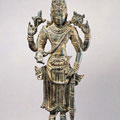|
|
 |
 |
| Vishnu and His Avatars |
|
|
The cult of Vishnu, like many of the great religious traditions of Hindu South Asia, is thought by scholars to be an amalgam of diverse religious traditions and practices. These were absorbed into the Vishnu tradition through the idea of incarnation (avatara, which literally means "crossing over") and through the integration of different local traditions and divine personalities into one central character. Vishnu is said to have ten major incarnations, or occasions when he takes form in the world to save his devotees: the tenth incarnation has yet to take place. Vishnu is often portrayed as a king, dressed in royal regalia and carrying a conch shell, a lotus, and his distinctive weapons, the club and discus (Figures 1 and 2). He is often portrayed with Shri, also called Lakshmi, the auspicious Goddess of fortune.
One extremely popular incarnation, Krishna, encompasses a number of characters: the same deity is the child-God of Braj, the young charioteer in the Bhagavad Gita who encourages the faltering Arjuna to fight in battle, and, in his adult life, the ruler of Dwarka. The diversity of Krishna's personalities encompasses many of the more popular forms of devotion (bhakti). One can love God as a mother loves a child, or as a lover pines for the beloved. Thus Krishna is beloved as the adorable but naughty child-deity who tried his devoted mother's patience by stealing butter and yogurt, his favorite foods, and is also famous for bewitching the young milkmaids of Braj, the region south of Delhi where he grew up, and luring them away from their husbands.
In the Bhagavata Purana (Figure 3), a text written in the beginning of the first millennium, and in the Bhagavad Gita, Krishna is himself revealed as the ultimate, all-powerful deity. This is expressed succinctly in a popular tale about one of his childhood pranks. Attempting to discern what her mischievous son has eaten, Krishna's mother orders him to open his mouth, and when he does so, she sees the universe in all its glory -- her young child contains all the world within him. She is then granted peace by her son, who allows her to see him as she did before, simply as the adorable son to whom she is devoted. Thus, Krishna is not subordinate to Vishnu as an "incarnation"; he is complete and absolute in himself, and devotion to him is a valid means of reaching oneness with ultimate reality. Krishna, whose name means "dark," is often portrayed with blue skin, which alludes to his connection to Vishnu, who is also blue.
Another popular avatara of Vishnu is Rama, the hero of the epic the Ramayana, who is usually portrayed with a bow and arrow (Figure 4) and often accompanied by his wife, Sita, and his brother Lakshmana. The Ramayana centers on the exile of Rama from his father's kingdom along with his wife and brother, and the adventures the three encounter. Sita is kidnapped by the demon Ravanna, who rules the island of Lanka, and Rama's quest to retrieve her constitutes the greatest of the many adventures recounted in the epic. The story of Rama has been told and retold for millennia across South and Southeast Asia, and has appeared in many forms -- as folk tale, performance, and literary text. The Sanskrit version by Valmiki was composed more than two millennia ago, but there are other immensely popular versions in vernacular languages, such as Kampan's 12th-century Tamil text Iramavataram, and Tulsidas' 16th-century Hindi poem known as Ramcaritmanas ("The Holy Lake of the Acts of Rama").
< previous next >
Top |
|
 |
 |
| Click for details |
 |
 |
 |
Fig. 1
|
 |
 |
 |
Fig. 2
|
 |
 |
 |
Fig. 3
|
 |
 |
 |
Fig. 4
|
 |
|
 |


